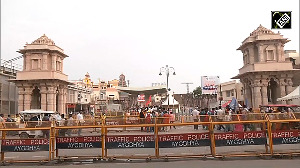The two nations share a problem of corporate debt gone bad that is so large and so opaque that it is difficult to gauge how bad things are, notes Rahul Jacob.
 Do China and India have anything in common besides being the only countries with a population in excess of 1 billion?
Do China and India have anything in common besides being the only countries with a population in excess of 1 billion?
China may be several decades ahead economically, but on the evidence of the past few weeks, the two nations share a problem of corporate debt gone bad that is so large and so opaque that it is difficult to gauge how bad things are.
A new analysis on China calculates off-balance sheet credit commitments and commercial banks' unconsolidated debt to be almost 50 per cent larger than hitherto reported.
China is the most financially leveraged country in Asia with a debt-to-GDP (gross domestic product) ratio of about 340 per cent, not 285 per cent of GDP as earlier reported.
India's corporate indebtedness does not look as ugly - but for its steel and infrastructure sector, where arguably it looks even worse.
Late last month, Credit Suisse released the latest sequel to its scary "House of Debt" corporate horror show.
First done three years ago, this progress report on the health of the most indebted of India's corporate groups - ranging from the Adani Group to Jaypee to Videocon - found that in aggregate their debt is now seven times what it was eight years ago.
In fiscal 2015, debt continued to rise "even as some groups cut back on (capital expenditure) and looked to sell assets."
What's worse is that their ability to repay debt is declining rather than improving. This is partly the result of difficult economic conditions but often because they are selling their most viable businesses first: Deleveraging is having the opposite effect of what one might expect.
Many companies in the group have seen debt-to-EBITDA (earnings before interest, taxes, depreciation and amortization) ratios become even worse.
Credit Suisse cites Jaypee Group, which has sold cement businesses and hydro plants, but in doing so has pared assets that contributed 59 per cent of its earnings before interest and taxes in fiscal 2015.
Infrastructure companies in the grouping, CS reports, have seen their debt "outpace the rise in capex by… 120 to 195 per cent. Many of their projects now have 20 to 70 per cent cost overruns."
Looking out into the future, things are likely to get worse - much worse - before they get better as banks are put under pressure to classify more of these loans as non-performing.
Credit Suisse looked at auditors' reports of these companies and found that "total debt with these companies in default was at $53 billion of which $37 bn was reported to be in default for 0 to 90 days by the auditors.
While some of these accounts are (classified as) 'restructured' at the banks, most of them continue to be classified as 'standard.'
China's huge shadow financing system and poorer auditing standards make rectifying Indian banking's problems seem less intractable.
After poring over the third-quarter reporting data of 1,700 companies (excluding energy and financials), a financial analyst in Beijing reports that both profit and revenue growth have recently slowed sharply.
"The working capital position of listed corporates is now deteriorating at the fastest rate since 2012," he observes. The seven per cent drop in exports and 19 per cent plunge in imports in October show no signs of a pick-up.
The renowned China analyst Anne Stevenson-Yang reported recently on a conversation with an asset broker who is helping financial institutions offload their non-performing loans "without needing to acknowledge them."
He described a Ponzi scheme that poses as debt restructuring where brokers buy non-performing loans (NPLs) and sell off some of the collateral.
The collateral that can't be sold, often real estate in a country seemingly with more empty apartments than people, is then bundled as collateral for "new borrowers who need assets" to get loans from banks.
"There is a good market for these asset packages," the broker told Stevenson-Yang. "Many companies want to IPO but they don't have enough assets to qualify. We sell them some cheap NPLs."
Back in India, this week saw Adani Ports' shares hit a 52 week low after the company announced that it was acquiring a port in Tamil Nadu for Rs 2,000 crore (Rs 20 billion). Bond yields for India's large steel companies such as JSW Steel and Tata Steel have been surging. "The industry owes $43.8 bn of loans, an increasing amount of it close to delinquency," a report from Bloomberg noted.
Despite this grim backdrop, it is impressive that the most recent quarterly survey by Barclays of 650 asset managers found that while investors in emerging markets are worried about whether things could get worse in China, India is considered the most attractive emerging market by 38 per cent.
But, as the Financial Times observes, India's price-to-book multiple at 3.2 times is already well above the average of emerging markets of 1.4 times.
Those who criticise Prime Minister Narendra Modi's persistent globe-trotting are wrong to do so - even, to borrow a phrase from his party's mean-spirited playbook, anti-national.
President Xi JInping might have created much bigger waves recently in the US, UK and Singapore, but Mr Modi's foreign trips at least arguably help the economy. With such high corporate indebtedness in China and India, distracting foreign institutional investors from focusing on the glaring weaknesses of our respective economies buys time - in India's case, to restructure debt, to put in place effective regulators to price electricity right so our state electricity boards don't go bankrupt again, to create independently managed state-owned banks and even put in new laws on bankruptcy that make pursuing large corporate defaulters worthwhile.
The recurring question since 1991 is: Will the government have the discipline to do so?
If you believe the answer is yes, I know of a broker who would like to offload billions of NPLs.










 © 2025
© 2025